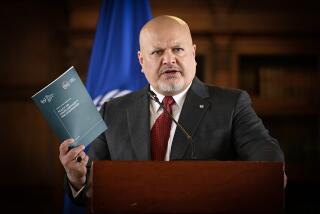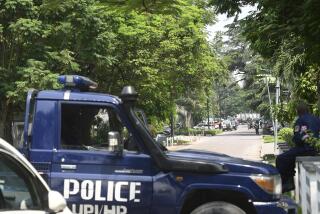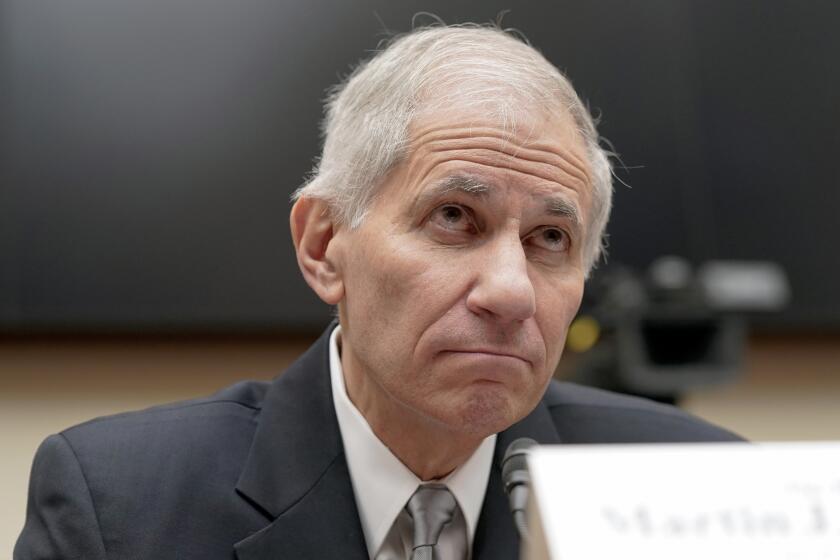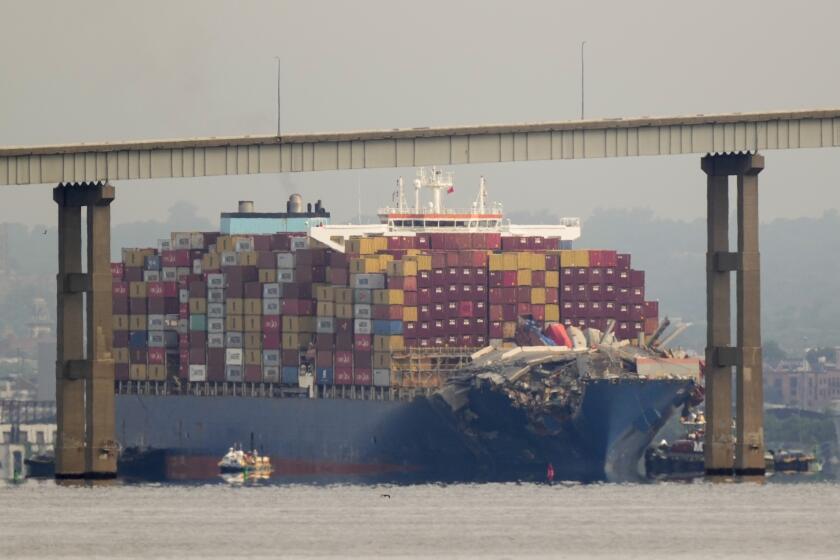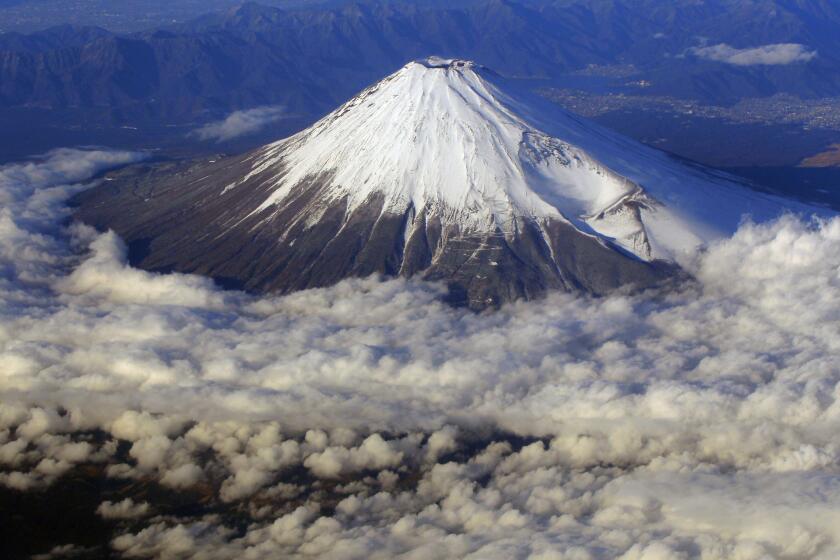Hope Dims for Ending U.S. Military’s Turf Wars : Defense: Service branches feud over functions and arms. Congress had set up commission to reduce duplication and waste.
The Navy wants to stop the Air Force from controlling all “deep-strike” bombing missions.
The Army wants to edge the Marines out of the action in fighting major land wars.
The Marines are looking for a few good tanks--most of which are now owned by the Army.
The Air Force is angling for its own warplanes--and not the Navy’s carrier-borne aircraft--to be the first to respond to trouble anywhere around the globe.
Welcome to the world of “roles and missions”--the armed services’ lengthy and heated effort to redefine which functions each should perform and what kinds of weapons each should have in the post-Cold War era.
After years of Defense Department refusals to tackle the issue--and a couple of false starts by the military itself--Congress last year finally set up an independent Commission on Roles and Missions to referee the fracas.
But the exercise, only a few months old, has already degenerated into a military food fight, dimming hopes that any serious sorting-out actually will be achieved:
* The Air Force, in what some complain was a last hurrah by its outgoing chief of staff, Gen. Merrill A. McPeak, put down some markers that outraged leaders of the three other services.
* The Clinton Administration has yet to provide any real leadership in the effort. Insiders say top Pentagon officials, seeking only to protect the existing military structure, have discouraged any further discussion on how to reshape the armed forces.
* The Roles and Missions Commission itself has hinted that it is unlikely to recommend sweeping changes. John P. White, the chairman, says the panel will hew mainly to ideas that seem “implementable” and avoid any “dramatic . . . solutions.”
The issue is important because duplication in the military has reached such proportions that some analysts say it is impeding effectiveness and siphoning off badly needed defense dollars that could be better used for modernization and preparedness.
Robert H. Gaskin, a former Pentagon strategist, argues that with the defense budget under pressure--and new technology altering the way America goes to war--streamlining the military “is one of the critical defense issues we face.”
“We now have a once-in-a-lifetime chance to consolidate our military Establishment and improve the way the individual services work together,” Gaskin said. “What is being done now could have a serious impact for decades to come.”
The battle over roles and missions has been going on virtually since the invention of the airplane. Before that, the division of labor was simple: The Army fought the nation’s land wars and the Navy fought its sea battles. Few conflicts arose.
Military aviation changed all that. Former Sen. Barry Goldwater (R-Ariz.) has observed that the United States is the only major power in the world that maintains four distinct air forces. (The Army, Navy, Marines and Air Force all have warplanes.)
Overlaps mushroomed during the Cold War, as planners found that some redundancy was necessary insurance in case part of the U.S. force was wiped out. Interservice rivalry fueled the competition. Sophisticated new technology blurred the lines even more.
Today, repetition is rampant. Army helicopters and Air Force and Marine Corps fighters can provide cover for U.S. ground troops. The Navy, Air Force and Army are equipped to send bombs or missiles far into enemy territory. And all defend against enemy planes and missiles.
Senate Armed Services Committee Chairman Sam Nunn (D-Ga.), the major force behind the current effort, has suggested that the military might be able to save billions of dollars by sorting out such functions more carefully and eliminating some of the duplication.
Nunn also has pinpointed a spate of redundant institutions, including separate medical, legal and chaplains’ corps for each service, that he says might be run more efficiently if they were combined.
Williamson Murray, a military historian at Ohio State University, argues that the roles-and-missions exercise should aim for more than mere budget-cutting. The goal, he says, should be reshaping the military to adapt to the new post-Cold War threats and to exploit today’s technology.
With the Cold War over, he says, the military must eliminate the redundancies that were permitted when the United States and Soviet Union were at odds. “My guess is that we can’t fix them all,” he said. “But we have to do a better job.”
Dan Goure, an analyst with the Center for Strategic and International Studies, wishes that the debate would spur fundamental decisions on using ground forces and air power.
“Ideally, this discussion should be helping to resolve the whole question of the military’s role in carrying out U.S. foreign policy,” he said. “It’s a real opportunity--not just to redivide the pie but to redefine the entire menu.”
Some analysts argue that not all duplications are wastes. The Marines’ way of conducting ground combat operations, for example, is far different from the Army’s. Its pilots are trained specially to provide air cover that fits that mold.
And in some cases, merging two or more seemingly duplicate entities might not save much money at all. The military still would need the same number of physicians, lawyers and chaplains as it has now, for example, even if they were combined under a single service.
Andrew F. Krepinevich, director of the Defense Budget Project, a defense-monitoring group, argues that saving money is not the only reason for the roles-and-missions exercise. Even the most radical proposals would not fully relieve the military’s budget problem.
The Pentagon has begun some modest efforts. The Joint Chiefs of Staff recommended last year that the services combine all basic flight training under one roof. And the four may consolidate at least some of their supply depots.
But Nunn and other critics argue that the reform should go far beyond such peripheral issues to broader questions--such as which service should be charged with projecting U.S. air power, which should fight the major land wars and which should provide close air support.
“The fundamental question is not what is best for the Navy or the Air Force,” Nunn said. “The question is, what is best for America.”
To Gaskin, now with Business Executives for National Security, a defense monitoring group, that means dividing the battlefield into segments--from outer space to the rear areas behind the battlefield--and “looking at what each service brings to the table.”
By those standards, at least, McPeak’s controversial proposals go furthest.
The former Air Force chief of staff wants the Pentagon to give his service--rather than the Navy--the primary job in projecting U.S. military power to potential global trouble spots, arguing that it would be faster and cheaper than maintaining 12 aircraft carriers worldwide.
Under his proposal, the Air Force would also control all strategic bombing and missile strikes, and it would take over complete responsibility for defense against air and missile attacks. Providing close air support for ground troops would be left to the Army and Marines.
The other services are battling to protect their turf. The Marines, resisting McPeak’s proposal to bar them from anything beyond providing close air support for troops, want to maintain their tactical air wings.
Navy officials argue that the United States might not always be able to win permission to use other countries’ airfields for bombing missions, as the former Air Force chief’s plan would require. They also counter that launching ship-based Tomahawk missiles for deep-strike operations is often faster and more effective than sending squadrons of bombers.
A few weeks ago, in a rare move, the chiefs of the Army, Navy and Marine Corps angrily signed a joint memo opposing a related McPeak move to have the Air Force assume control of all military operations in space.
Maj. Gen. Thomas L. Wilkerson, the Marine Corps’ point man on the roles-and-missions debate, says he finds it “ironic” that the Air Force is trying to segment the battlefield at a time when the services have begun to perfect their ability to operate jointly, as a team.
“Gen. McPeak is assuming that the enemy will ‘get the lecture’ and go along with what he proposes,” Wilkerson said. “Actually, the enemy will draw his own lines, and we need to have the flexibility to meet that threat.”
McPeak’s proposal is not the only roles-and-missions battleground. The Army and Marine Corps, for example, are fighting over which should get more of the ground action in post-Cold War military operations.
The Army wants recognition as the primary service for fighting “sustained” land wars, leaving the Marines to play a limited role in more modest, short-term operations, such as peacekeeping duty in Haiti. It also is moving deeper into the area of amphibious operations.
The Marines, seeking to widen their own role, want more Army tanks and V-22 Osprey troop-carrying aircraft.
The coming free-for-all is not expected to be tidy. The services have begun campaigning, not only among members of the Roles and Missions Commission, but also among their longtime supporters in Congress.
To its credit, the 11-member Roles and Missions Commission has taken a step toward some reform. The panel’s ambitious, 26-issue agenda includes such topics as improving joint war fighting, streamlining the current command structure and sorting out military air operations. It plans to issue final recommendations within six months.
But the commission has only a small staff, and many of its members are retired military officers long identified with preserving the status quo. The panel itself has been meeting only once a month, and not everyone shows up. Skeptics question whether it is up to the job.
Military Overlap
A look at the four services’ overlapping roles in various situations:
Air Role or mission Army Navy Force Forward presence Divisions Aircraft Aircraft deployed in carrier stationed Europe, battle groups in Europe, South Korea always at sea Asia Global attack None Carrier U.S.-based planes, B-52s, B-1s, cruise B-2s missiles Deep strike Long-range Carrier All bombers into enemy rockets, planes, and fighters territory missiles cruise missiles Defense against Patriot F-14, F/A-18 F-15, F-16 planes and missiles, fighters fighters, missiles others AWACS planes Close air Apache, F-18C fighters All fighters support for Cobra ground troops helicopters
Role or mission Marines Forward presence Amphibious forces always afloat Global attack None Deep strike None into enemy territory Defense against F/A-18 planes and fighters missiles Close air F-18Cs, support for helicopters ground troops
More to Read
Start your day right
Sign up for Essential California for news, features and recommendations from the L.A. Times and beyond in your inbox six days a week.
You may occasionally receive promotional content from the Los Angeles Times.
